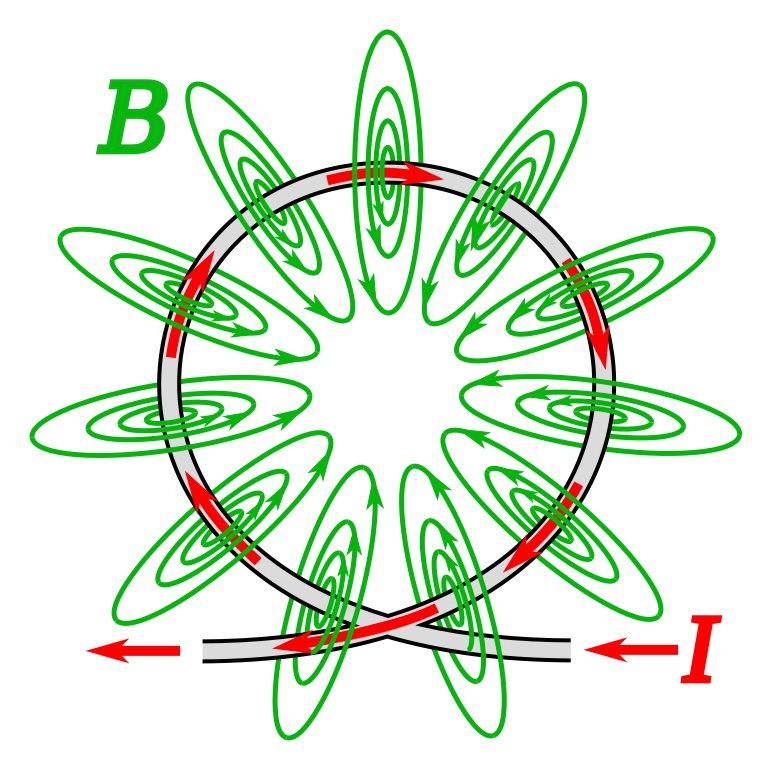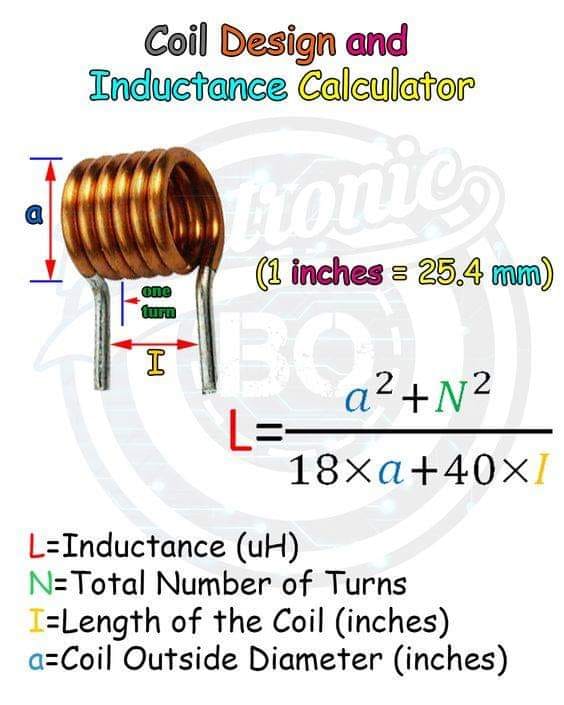
a part of a vehicle's engine that supplies high voltage electricity to the spark plugs.
A coil is an Inductor.

Coil Resonant Frequency Calculator
A Coil:
1- Concentrates its magnetic field at the center of coil
2- Resists changes to electric current flowing through it
3- Stores magnetic field
4- Emits a short pulse 10X its energizing current when de-energized
5- Is a mirror function of a capacitor in its circuit
Russell
"The first wrongly assumed premise is that the wire coil creates a magnetic field. It creates an electric field, not a magnetic one. There are no magnetic fields in Nature. There are electric fields of curved motion, which are bounded by magnetic planes of non-motion and zero curvature." [Atomic Suicide, page 272]
"Step No. 2. The cylindrical coil made for the creation of an electric field does not, in any respect, conform with the electric current, which divides the stillness of cathodes into moving pairs, for the purpose of multiplying the motion of those moving pairs to create the heat and compression necessary to simulate the IDEA, which concentrated electric Mind-thinking desires to give objective expression to." [Atomic Suicide, page 273]
"Their coil of motion, which caused the division, turns but one way, just as the sphere which you have held between your hands, turns but one way. The particles have been ejected from that coil in an angle of 90 degrees from their plane of motion yet it is now held that these particles turn right-handed from one end to turn in the direction of its motion, and particles ejected from the other end turn left-handed for the same reason." [Atomic Suicide, page 282-283] See Fieldless Armature
"It is a commonly known fact by every physicist and laboratory worker that electricity runs only in the direction of the turnings in a solenoid coil. Every such worker is also perfectly familiar with the effect of polarization which evidences its effect at 90 degrees from the direction - and plane - of the electric current. These two seeming directions, and effects, are confusing to him for the idea of polarization, as an extension of stillness, has not yet entered his thinking." [Atomic Suicide, page 283-284]
"We now go into the laboratory. The physicist makes a two-way gun, which he calls a coil. He does not seal one end of it for he cannot. His electric current goes both ways and spins around its extending shaft in equality of potential. In this way he divides gravity and extends it in such a manner that both of each pair of mates, thus divided, are equal." [Atomic Suicide, page 292-293]
"In the coil, above described, there is no material body occupying the cathode position as there is when a plane, or bullet, starts to move. In the Lee-Yang experiment a material body is placed there to be polarized. Cobalt is not a balanced, mated pair, like carbon, however. It is but one of a pair, although it is very close to the balanced amplitude point of its wave. When the current is turned on the resultant effect is as though a steel rod was inserted in the shaft of the coil, which is a half inch in diameter at one end and a quarter of an inch at the other end. Every physicist knows that both ends would then be different, for the equator of the rod would not be in the middle. It would be nearer the small end. The rod would not pick up an equal weight at its opposite ends, for the electric potential which does the lifting, would be unequal. The small end would pick up a greater weight, for its rings would be smaller and spin faster." [Atomic Suicide, page 293]
Schauberger
(2) "A process for the liquefaction of gases by the Joule–Thomson effect. In this process devised by Carl von Linde (1842-1934) for liquefying air, the air is freed of carbon dioxide and water and compressed to 150 atmospheres. The compressed gas is passed through a copper coil to an expansion nozzle within a Dewar flask. The emerging air is cooled by the Joule–Thomson effect as it expands and then passes back within a second copper coil that surrounds the first coil. Thus the expanded gas cools the incoming gas in a process that is said to be regenerative. Eventually the air is reduced to its critical temperature and, at the pressure of 150 atmospheres (well above its critical pressure), liquefies. The process is used for other gases, especially hydrogen and helium. Hydrogen has first to be cooled below its inversion temperature (see Joule–Thomson effect) using liquid air; helium has first to be cooled below its inversion temperature using liquid hydrogen." [Collins Dictionary of Science. Oxford University Press, Great Britain, 1984, ISBN 0-19-211593-6.] — Ed [The Energy Evolution - Harnessing Free Energy from Nature, The Liquefaction of Coal by Means of Cold Flows]
This invention (see fig. 17) relates to a conduit or pipe for liquid or gaseous media, which is intended to prevent encrustation and to reduce flow losses, wherein the pipe cross-section is formed of several curved arcs of a circle and the pipe is coiled in a screw-form manner. The invention also consists in the fact that the cross-section is egg-shaped with an indentation on one side adjacent to the pointed end of the egg and that the pipe is first twisted upon itself before the whole is formed into a coil. With the aid of such a pipe, the conveying capacity and efficiency is improved due the reduction of frictional losses and the prevention of encrustation. In order to increase the conveying capacity, the coiling of the pipe around an imaginary cylinder has proved to be particularly effective. For the same reason, the pipe can be rotated in a normal manner, whereby the central axis of the coiled pipe arrangement is also the axis of rotation. It is also advantageous to narrow the cross-section of the twisted pipe. [The Energy Evolution - Harnessing Free Energy from Nature, Schauberger Patent 196680 - Pipe for Liquid and Gaseous Media]
Resonant inductive coupling or magnetic phase synchronous coupling is a phenomenon with inductive coupling where the coupling becomes stronger when the "secondary" (load-bearing) side of the loosely coupled coil resonates. A resonant transformer of this type is often used in analog circuitry as a bandpass filter. Resonant inductive coupling is also used in wireless power systems for portable computers, phones, and vehicles. wikipedia
See Also
angles of 90 degrees
cold center
cold cube of space
Cold Fusion
cold multiplies electric potential
cold multiplies memory
cold space
Cold
Electric Coil
Electric Current
Electricity
electromagnet
Figure 16.06 - Russells Genero-Radiative Coils - Electricity Expands and Contracts
Figure 17.02 - Gravity divides multiplies and balances Light and Sound
Figure 5.7 - Vortices on Three Planes 90 Degrees to Each Other
Figure 8.3 - Coiled Spring showing Longitudinal Wave
Inductor
Light Rings formed at 90 Degrees to Magnetic Center Line
Magnet
Magnetic Field
Magnetism
memory of the electric coil
Memory of the motion
Memory
plane of 90 degrees
Polar
Polarization
Shape-memory Ni-Mn-Ga alloy
Solenoid
Stubblefield Coil
Tesla Coil
Tesla - U.S. Patent 0512340 bifilar coil
12.30 - Thermal Radiation and Thermal Vacuum or Cold
